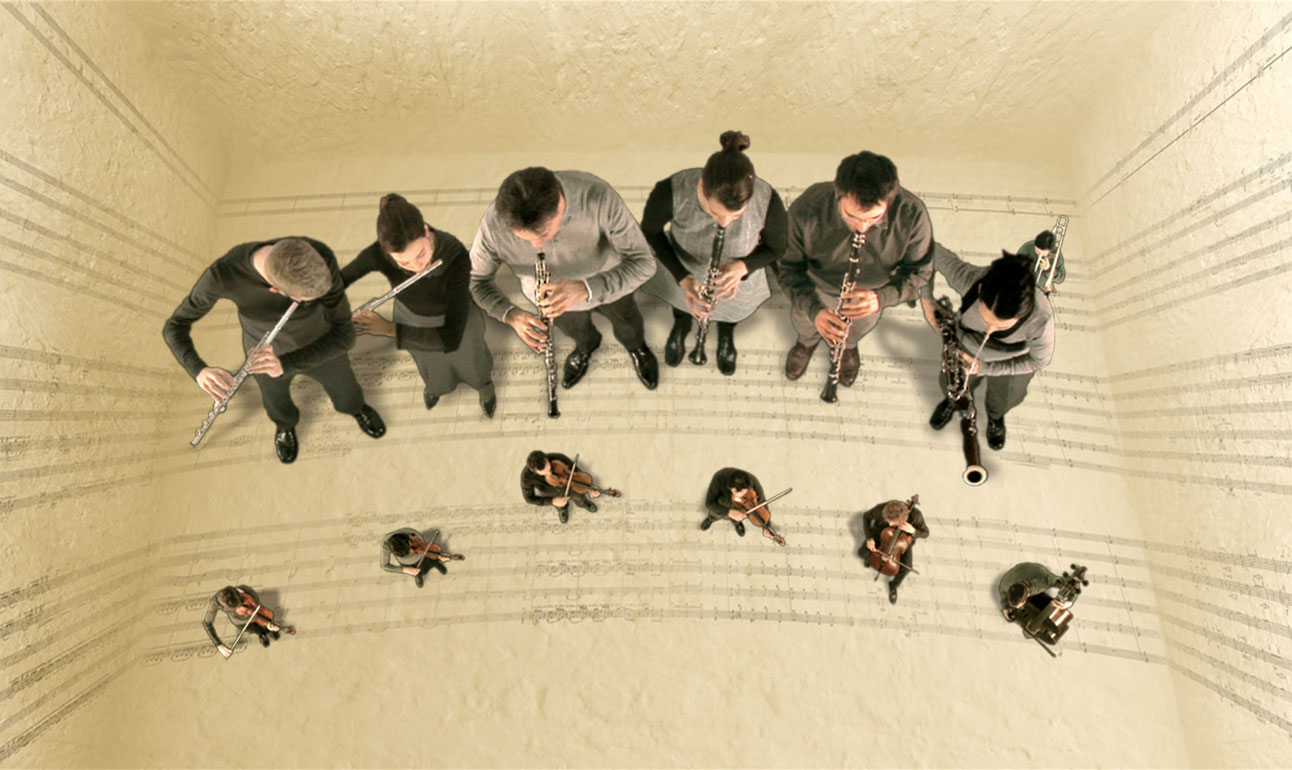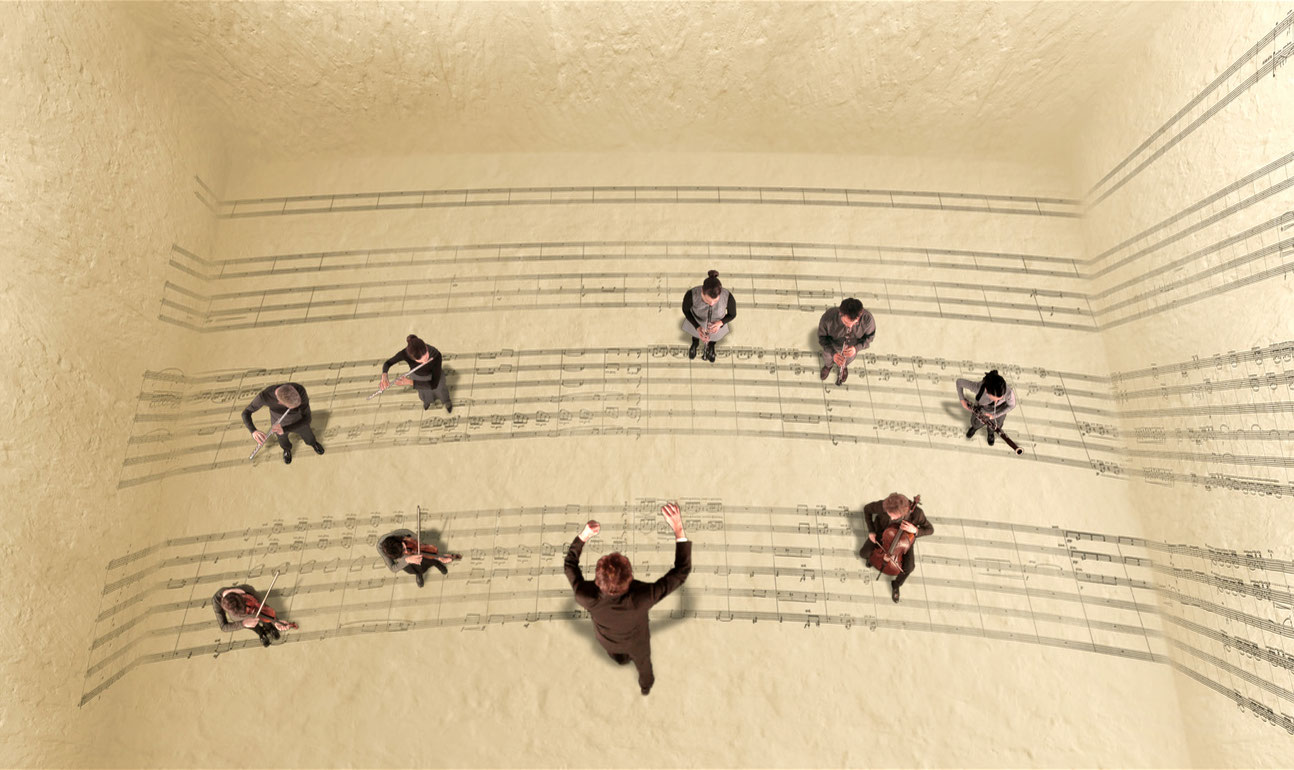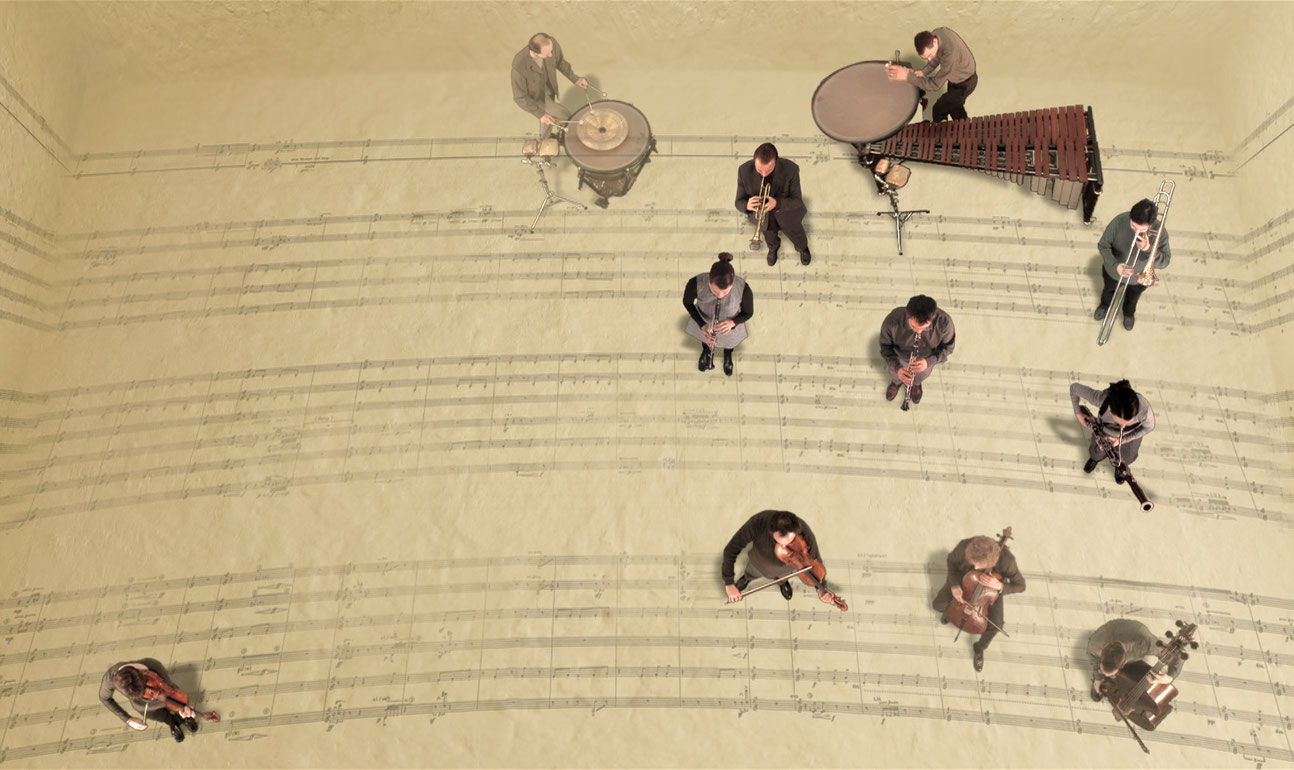Being and Nothingness
Being and Nothingness transforms a piece of music into a visual and examines the role of humans in this performance of sound and light. After a prologue in which composer and conductor Beat Furrer is shown obtaining and arranging a score by Schumann, its performance is the film´s actual theme: As the notes pass through the picture, the musicians of the Klangforum Wien ensemble appear and disappear according to their acoustic contribution. The result is a choreography of sound, and the music´s transience and vastness is turned into a ballet of bodies which, somewhere between presence and absence, commemorates the instability of being as a dialectic micro-spectacle.
Enjoyment of the music produces optical ghosts which - resembling the heads of musical notes - scurry across the picture, adding rhythm to the composition visually. As the musical texture thins out during the finale, the visual elements become increasingly fragmentary: a twitching at the edge of perception, a nervous optical irritation which partially settles into the subconscious. At the conclusion the conductor, who had previously entered thepandemonium of sounds as a deus ex machina, gratefully accepts the applause in a white cube. A white square on a white background, a complete defusing of the grand story, and the nadir in the production of sound.
Being-in-itself, wrote Sartre, is unchanging, undifferentiated pure being, simply the fullness of being without any sort of negation.
(Thomas Mießgang)
Being and Nothingness visualizes a fantastic journey into a musical score. The musicians appear and disappear in the same way as the notes and sounds. Bady Minck has given music a virtual space - and the main scene possibly plays out in the mind of the conductor and composer, who obliterates the musicians by means of a hand gesture...
(Martin Pieper)
Translation: Steve Wilder
What you see is what you hear in filmmaker Bady Minck´s visual treatment of an original composition by Beat Furrer. As the conductor masterfully tames time and commands silence, the dominance of music over the body is skillfully illustrated while the music becomes a living picture.
(Jason Buchanan, New York Times)
An orchestra conducted by Beat Furrer performs a score by Schumann. In turn the filmmaker plays with images instead of notes, making the musicians appear and disappear according to their participation. Visual score or chamber film, the performance is playful as much as enlightening — which is not bad at all when what is called into question is being and nothingness!
(Festival du Nouveau Cinéma de Montréal)
Some very special treats await lovers of experimental films at this year´s BIFF. Two eagerly anticipated titles, Bady Minck´s Being and Nothingness and Guy Maddin´s „Brand Upon the Brain!“, from established artist-filmmakers are among the highlights.
Those who remember Bady Minck´s incredible In the Beginning was the Eye will be overjoyed to hear of her latest outing. Like many in the avant-garde cinema, Minck brings a visual artist´s eye to the meticulous composition of her mixed-media films, with the result that her mesmeric animations fully deserve the mantle of „fine-art film“. Being and Nothingness continues her interest in inventive visual storytelling by extending her feeling for intense visual rhythms into the musical realm.
Minck´s work is the latest in a long line of visual music experiments that visualise fantastic journeys into musical scores, providing delight to the ears, as well as eyes. The sinuous pleasures of synaesthesia – the blending of the senses so that one „hears“ images and „sees“ sound – as well as Minck´s characteristic cheeky approach, lie in store for audiences with a penchant for experimental art.
(Danni Zuvela)
Kunstmatch zwischen Musik & Film (Article)
Das Klangforum Wien und Dirigent Beat Furrer eröffneten das Festival Wien Modern
Wien - Die Leinwand allein genügt nicht: Muntere Visuals flackerten über die Bühne und sammelten sich erst allmählich auf der riesigen weißen Fläche über den Köpfen des Klangforums. Zweite Feststellung: Hatte die Avantgarde früher versucht, die Kunst ins Leben überzuführen, so üben sich heutige Spielarten darin, das Leben bruchlos in die Kunst zu integrieren.
Denn man sah zunächst den Komponisten Beat Furrer mit seiner Partitur in einer Videoprojektion, dann kam er auch schon aufs Podium, um mit seinem Lied, das über das Ende des Liedes hinaus ein anderes Ende finden wollte zu eröffnen. Zugleich flimmerte ein Film über die Leinwand, der zeigte, wie die auf der Bühne spielten und vor der im Hintergrund ablaufenden Partitur, synchron zu ihren Einsätzen, ein- und ausgeblendet wurden.
Danach versammelte das Projekt "Free Radicals" gut zwanzig musikalische und filmische Programmpunkte mit ganz verschiedenen Konstellationen: nur Musik, nur Film, auch Musik mit Film oder aber Film mit Musik. Dass die Gewichtung hier stark variieren kann, zeigte sich im direkten Vergleich jener Fälle, wo ein Kurzfilm mit Soundscape oder Popmusik unterlegt war, mit drei neuen Filmmusiken zu "Le Retour à la Raison" von Man Ray. Hier konnten verschiedene Ansätze ähnlich schlüssige Ergebnisse haben oder, einmal, selbst drei Minuten lang erscheinen lassen.
Ähnlich langatmig wirkte ein unergiebiges Farbenspiel zu einer Chopin-Mazurka, kurzweilig aber unbebilderte Stücke von Schönberg, Stockhausen oder Aperghis. Dass das Projekt Höhen und Tiefen hatte, lag nicht nur an der divergierenden Musikqualität, sondern auch an einer Auswahl bei den Filmen, die man eigenwillig nennen kann.
Der Verdacht, dass die mit Bernhard Zachhuber und Andreas Lindenbaum vom Klangforum für das Konzept verantwortliche Bady Minck ihre witzigen Arbeiten, die den Abend einrahmten, in gutem Licht erscheinen lassen wollte, würde zu kurz greifen. Dennoch waren diese Film-Musik-Sequenzen die schlüssigsten, die, auf unaufdringliche Weise selbstreflexiv, zuerst Dirigent und Ensemble auf die Leinwand projizierten, dann ein Blatt Papier auf dem Schreibtisch der Filmemacherin zur Bühne machten und Momentaufnahmen aus ungewohnter Perspektive zeigten.
Der Umstand, dass der erste und letzte Film nicht nur eng an die Musik - zuletzt von Feldman - angelehnt waren, sondern auch mit je sieben Minuten Dauer mit Abstand die längsten visuellen Programmpunkte, holte zuletzt das Experiment wieder auf sicheren Boden zurück.
Das Sein und das Nichts
2007
Austria, Luxembourg
10 min



